Strategic Planning for Tourism and Leisure: Hong Kong Analysis
VerifiedAdded on 2021/05/31
|15
|5252
|36
Report
AI Summary
This report provides an in-depth analysis of strategic planning within the tourism and leisure sector in Hong Kong. It examines the functions of the Tourism Commission, its role in promoting tourism, and its strategic programs. The report explores stakeholder theory, identifying key actors in the industry and their roles. It evaluates the impact of the Tourism Commission's work across economic, social, environmental, and cultural dimensions, focusing on the benefits and challenges associated with developing historical monuments, tours, and hospitality functions. The analysis includes the historical context of buildings, their current functions, and their overall impact on the tourism industry, concluding with an assessment of the industry's sustainability and future development strategies. The report also considers the benefits of the tourism commission, the increased turnover of the tours and travel busienss, which will also increase the balance of trade of the Hong Kong. The increased tours and travel turnover in Hong Kong due to development of historical monuments and tours and travel program in Hong Kong and hospitality functions will attract the clients on international level and increase the overall foreign exchange reserve of country which will eventually strengthen the currency value of country on international level.

Running Head: STRATEGIC PLANNING FOR TOURISM AND LEISURE
0
0
Paraphrase This Document
Need a fresh take? Get an instant paraphrase of this document with our AI Paraphraser
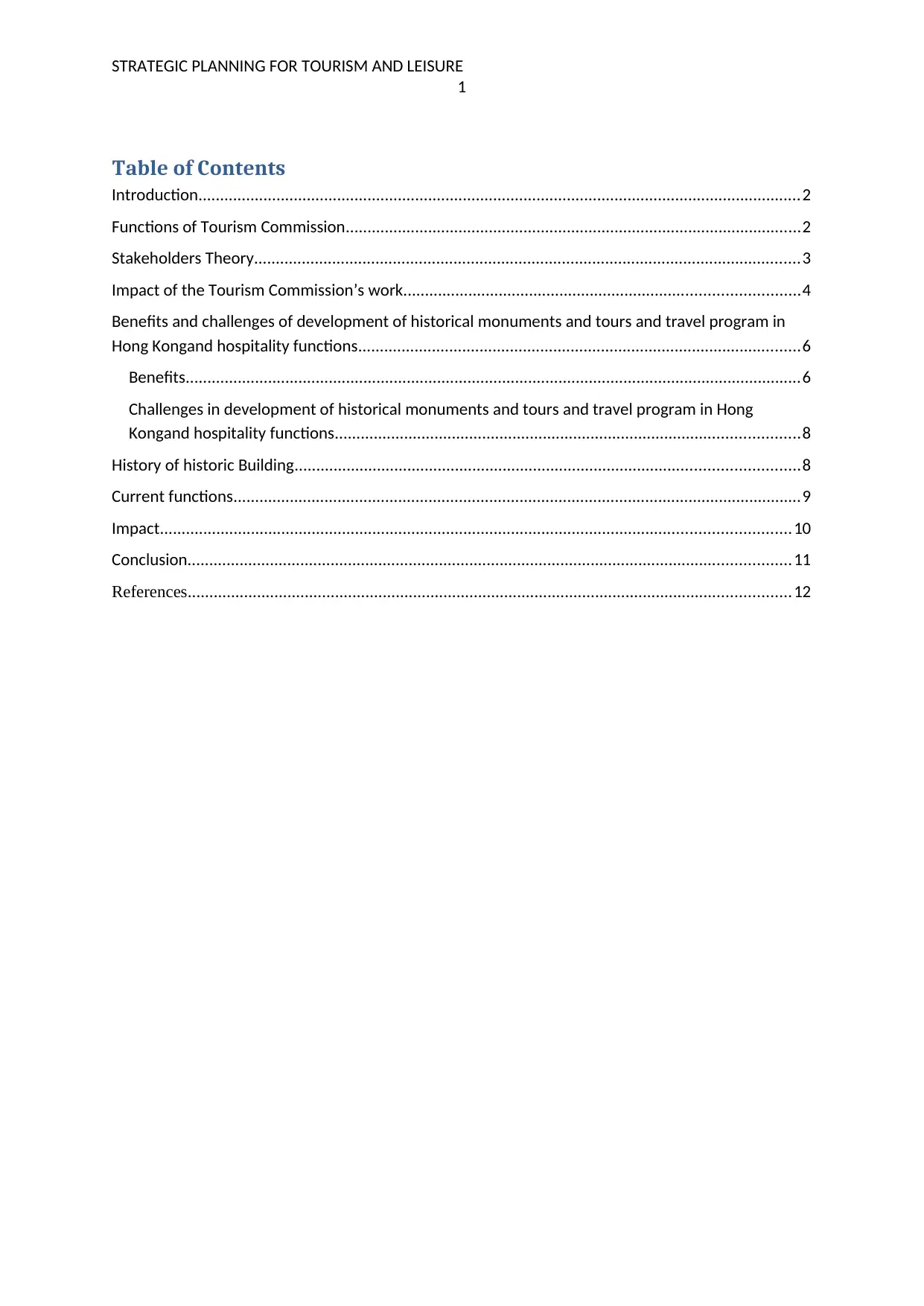
STRATEGIC PLANNING FOR TOURISM AND LEISURE
1
Table of Contents
Introduction...........................................................................................................................................2
Functions of Tourism Commission.........................................................................................................2
Stakeholders Theory..............................................................................................................................3
Impact of the Tourism Commission’s work...........................................................................................4
Benefits and challenges of development of historical monuments and tours and travel program in
Hong Kongand hospitality functions......................................................................................................6
Benefits..............................................................................................................................................6
Challenges in development of historical monuments and tours and travel program in Hong
Kongand hospitality functions...........................................................................................................8
History of historic Building....................................................................................................................8
Current functions...................................................................................................................................9
Impact.................................................................................................................................................10
Conclusion...........................................................................................................................................11
References...........................................................................................................................................12
1
Table of Contents
Introduction...........................................................................................................................................2
Functions of Tourism Commission.........................................................................................................2
Stakeholders Theory..............................................................................................................................3
Impact of the Tourism Commission’s work...........................................................................................4
Benefits and challenges of development of historical monuments and tours and travel program in
Hong Kongand hospitality functions......................................................................................................6
Benefits..............................................................................................................................................6
Challenges in development of historical monuments and tours and travel program in Hong
Kongand hospitality functions...........................................................................................................8
History of historic Building....................................................................................................................8
Current functions...................................................................................................................................9
Impact.................................................................................................................................................10
Conclusion...........................................................................................................................................11
References...........................................................................................................................................12
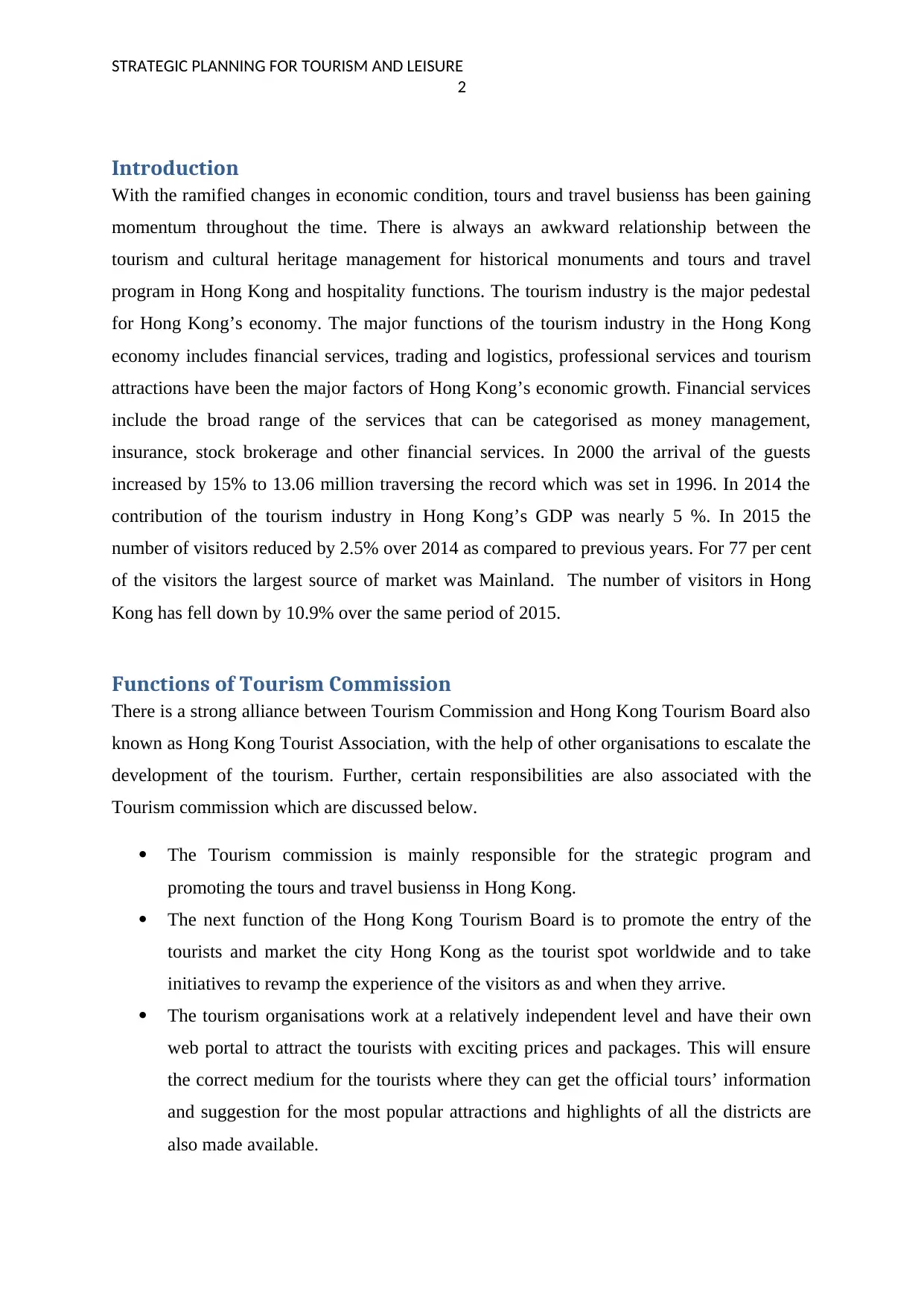
STRATEGIC PLANNING FOR TOURISM AND LEISURE
2
Introduction
With the ramified changes in economic condition, tours and travel busienss has been gaining
momentum throughout the time. There is always an awkward relationship between the
tourism and cultural heritage management for historical monuments and tours and travel
program in Hong Kong and hospitality functions. The tourism industry is the major pedestal
for Hong Kong’s economy. The major functions of the tourism industry in the Hong Kong
economy includes financial services, trading and logistics, professional services and tourism
attractions have been the major factors of Hong Kong’s economic growth. Financial services
include the broad range of the services that can be categorised as money management,
insurance, stock brokerage and other financial services. In 2000 the arrival of the guests
increased by 15% to 13.06 million traversing the record which was set in 1996. In 2014 the
contribution of the tourism industry in Hong Kong’s GDP was nearly 5 %. In 2015 the
number of visitors reduced by 2.5% over 2014 as compared to previous years. For 77 per cent
of the visitors the largest source of market was Mainland. The number of visitors in Hong
Kong has fell down by 10.9% over the same period of 2015.
Functions of Tourism Commission
There is a strong alliance between Tourism Commission and Hong Kong Tourism Board also
known as Hong Kong Tourist Association, with the help of other organisations to escalate the
development of the tourism. Further, certain responsibilities are also associated with the
Tourism commission which are discussed below.
The Tourism commission is mainly responsible for the strategic program and
promoting the tours and travel busienss in Hong Kong.
The next function of the Hong Kong Tourism Board is to promote the entry of the
tourists and market the city Hong Kong as the tourist spot worldwide and to take
initiatives to revamp the experience of the visitors as and when they arrive.
The tourism organisations work at a relatively independent level and have their own
web portal to attract the tourists with exciting prices and packages. This will ensure
the correct medium for the tourists where they can get the official tours’ information
and suggestion for the most popular attractions and highlights of all the districts are
also made available.
2
Introduction
With the ramified changes in economic condition, tours and travel busienss has been gaining
momentum throughout the time. There is always an awkward relationship between the
tourism and cultural heritage management for historical monuments and tours and travel
program in Hong Kong and hospitality functions. The tourism industry is the major pedestal
for Hong Kong’s economy. The major functions of the tourism industry in the Hong Kong
economy includes financial services, trading and logistics, professional services and tourism
attractions have been the major factors of Hong Kong’s economic growth. Financial services
include the broad range of the services that can be categorised as money management,
insurance, stock brokerage and other financial services. In 2000 the arrival of the guests
increased by 15% to 13.06 million traversing the record which was set in 1996. In 2014 the
contribution of the tourism industry in Hong Kong’s GDP was nearly 5 %. In 2015 the
number of visitors reduced by 2.5% over 2014 as compared to previous years. For 77 per cent
of the visitors the largest source of market was Mainland. The number of visitors in Hong
Kong has fell down by 10.9% over the same period of 2015.
Functions of Tourism Commission
There is a strong alliance between Tourism Commission and Hong Kong Tourism Board also
known as Hong Kong Tourist Association, with the help of other organisations to escalate the
development of the tourism. Further, certain responsibilities are also associated with the
Tourism commission which are discussed below.
The Tourism commission is mainly responsible for the strategic program and
promoting the tours and travel busienss in Hong Kong.
The next function of the Hong Kong Tourism Board is to promote the entry of the
tourists and market the city Hong Kong as the tourist spot worldwide and to take
initiatives to revamp the experience of the visitors as and when they arrive.
The tourism organisations work at a relatively independent level and have their own
web portal to attract the tourists with exciting prices and packages. This will ensure
the correct medium for the tourists where they can get the official tours’ information
and suggestion for the most popular attractions and highlights of all the districts are
also made available.
⊘ This is a preview!⊘
Do you want full access?
Subscribe today to unlock all pages.

Trusted by 1+ million students worldwide
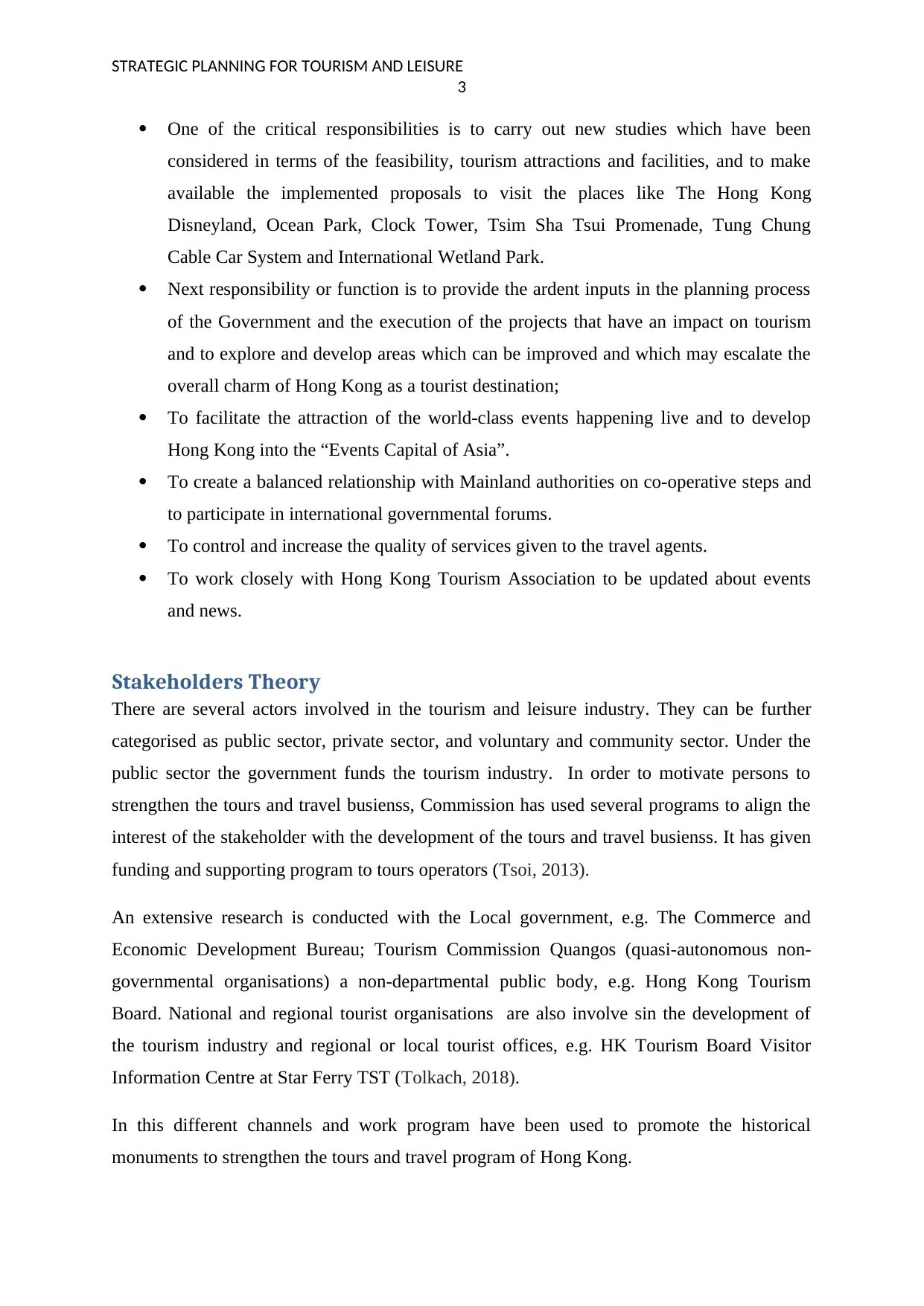
STRATEGIC PLANNING FOR TOURISM AND LEISURE
3
One of the critical responsibilities is to carry out new studies which have been
considered in terms of the feasibility, tourism attractions and facilities, and to make
available the implemented proposals to visit the places like The Hong Kong
Disneyland, Ocean Park, Clock Tower, Tsim Sha Tsui Promenade, Tung Chung
Cable Car System and International Wetland Park.
Next responsibility or function is to provide the ardent inputs in the planning process
of the Government and the execution of the projects that have an impact on tourism
and to explore and develop areas which can be improved and which may escalate the
overall charm of Hong Kong as a tourist destination;
To facilitate the attraction of the world-class events happening live and to develop
Hong Kong into the “Events Capital of Asia”.
To create a balanced relationship with Mainland authorities on co-operative steps and
to participate in international governmental forums.
To control and increase the quality of services given to the travel agents.
To work closely with Hong Kong Tourism Association to be updated about events
and news.
Stakeholders Theory
There are several actors involved in the tourism and leisure industry. They can be further
categorised as public sector, private sector, and voluntary and community sector. Under the
public sector the government funds the tourism industry. In order to motivate persons to
strengthen the tours and travel busienss, Commission has used several programs to align the
interest of the stakeholder with the development of the tours and travel busienss. It has given
funding and supporting program to tours operators (Tsoi, 2013).
An extensive research is conducted with the Local government, e.g. The Commerce and
Economic Development Bureau; Tourism Commission Quangos (quasi-autonomous non-
governmental organisations) a non-departmental public body, e.g. Hong Kong Tourism
Board. National and regional tourist organisations are also involve sin the development of
the tourism industry and regional or local tourist offices, e.g. HK Tourism Board Visitor
Information Centre at Star Ferry TST (Tolkach, 2018).
In this different channels and work program have been used to promote the historical
monuments to strengthen the tours and travel program of Hong Kong.
3
One of the critical responsibilities is to carry out new studies which have been
considered in terms of the feasibility, tourism attractions and facilities, and to make
available the implemented proposals to visit the places like The Hong Kong
Disneyland, Ocean Park, Clock Tower, Tsim Sha Tsui Promenade, Tung Chung
Cable Car System and International Wetland Park.
Next responsibility or function is to provide the ardent inputs in the planning process
of the Government and the execution of the projects that have an impact on tourism
and to explore and develop areas which can be improved and which may escalate the
overall charm of Hong Kong as a tourist destination;
To facilitate the attraction of the world-class events happening live and to develop
Hong Kong into the “Events Capital of Asia”.
To create a balanced relationship with Mainland authorities on co-operative steps and
to participate in international governmental forums.
To control and increase the quality of services given to the travel agents.
To work closely with Hong Kong Tourism Association to be updated about events
and news.
Stakeholders Theory
There are several actors involved in the tourism and leisure industry. They can be further
categorised as public sector, private sector, and voluntary and community sector. Under the
public sector the government funds the tourism industry. In order to motivate persons to
strengthen the tours and travel busienss, Commission has used several programs to align the
interest of the stakeholder with the development of the tours and travel busienss. It has given
funding and supporting program to tours operators (Tsoi, 2013).
An extensive research is conducted with the Local government, e.g. The Commerce and
Economic Development Bureau; Tourism Commission Quangos (quasi-autonomous non-
governmental organisations) a non-departmental public body, e.g. Hong Kong Tourism
Board. National and regional tourist organisations are also involve sin the development of
the tourism industry and regional or local tourist offices, e.g. HK Tourism Board Visitor
Information Centre at Star Ferry TST (Tolkach, 2018).
In this different channels and work program have been used to promote the historical
monuments to strengthen the tours and travel program of Hong Kong.
Paraphrase This Document
Need a fresh take? Get an instant paraphrase of this document with our AI Paraphraser
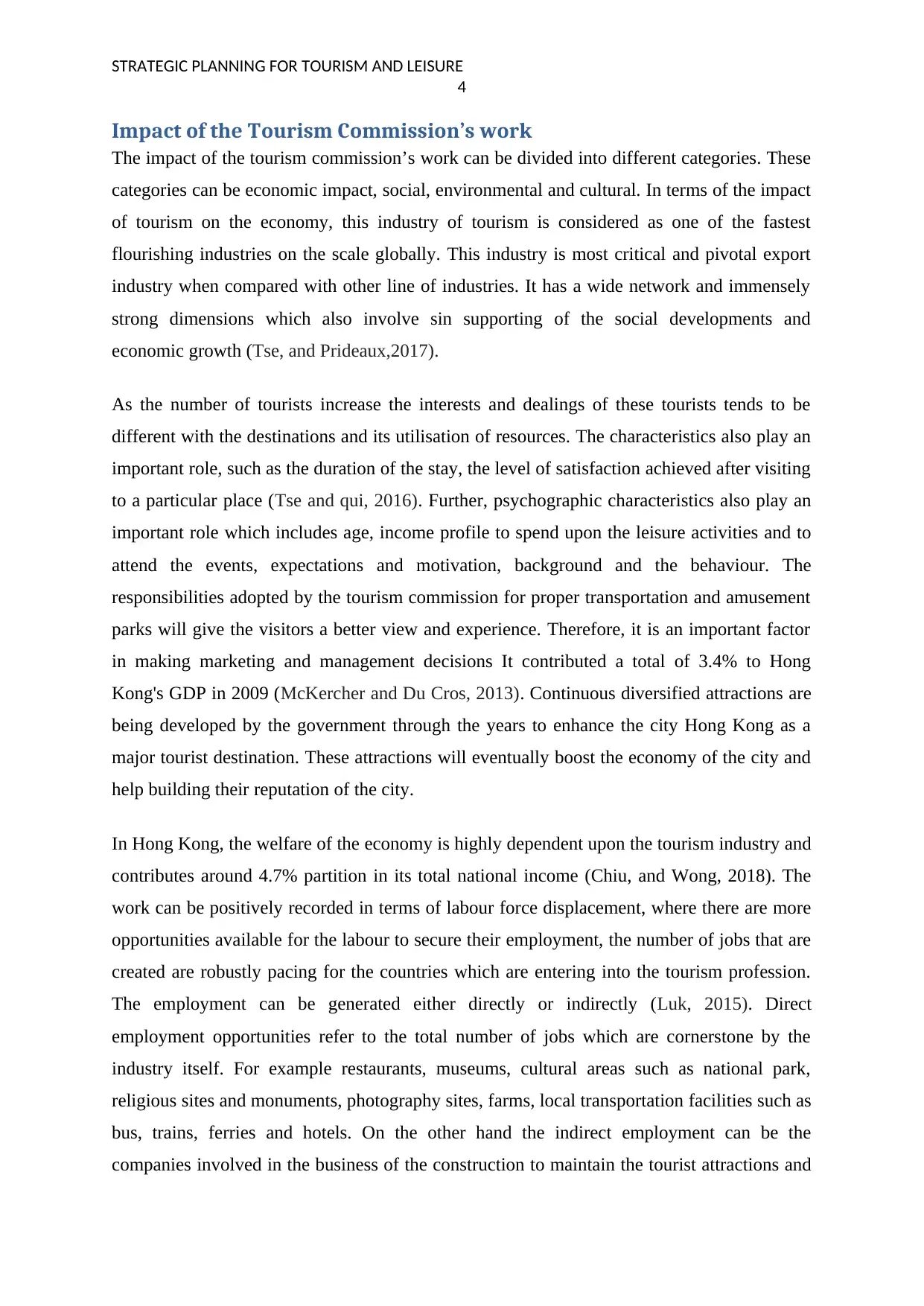
STRATEGIC PLANNING FOR TOURISM AND LEISURE
4
Impact of the Tourism Commission’s work
The impact of the tourism commission’s work can be divided into different categories. These
categories can be economic impact, social, environmental and cultural. In terms of the impact
of tourism on the economy, this industry of tourism is considered as one of the fastest
flourishing industries on the scale globally. This industry is most critical and pivotal export
industry when compared with other line of industries. It has a wide network and immensely
strong dimensions which also involve sin supporting of the social developments and
economic growth (Tse, and Prideaux,2017).
As the number of tourists increase the interests and dealings of these tourists tends to be
different with the destinations and its utilisation of resources. The characteristics also play an
important role, such as the duration of the stay, the level of satisfaction achieved after visiting
to a particular place (Tse and qui, 2016). Further, psychographic characteristics also play an
important role which includes age, income profile to spend upon the leisure activities and to
attend the events, expectations and motivation, background and the behaviour. The
responsibilities adopted by the tourism commission for proper transportation and amusement
parks will give the visitors a better view and experience. Therefore, it is an important factor
in making marketing and management decisions It contributed a total of 3.4% to Hong
Kong's GDP in 2009 (McKercher and Du Cros, 2013). Continuous diversified attractions are
being developed by the government through the years to enhance the city Hong Kong as a
major tourist destination. These attractions will eventually boost the economy of the city and
help building their reputation of the city.
In Hong Kong, the welfare of the economy is highly dependent upon the tourism industry and
contributes around 4.7% partition in its total national income (Chiu, and Wong, 2018). The
work can be positively recorded in terms of labour force displacement, where there are more
opportunities available for the labour to secure their employment, the number of jobs that are
created are robustly pacing for the countries which are entering into the tourism profession.
The employment can be generated either directly or indirectly (Luk, 2015). Direct
employment opportunities refer to the total number of jobs which are cornerstone by the
industry itself. For example restaurants, museums, cultural areas such as national park,
religious sites and monuments, photography sites, farms, local transportation facilities such as
bus, trains, ferries and hotels. On the other hand the indirect employment can be the
companies involved in the business of the construction to maintain the tourist attractions and
4
Impact of the Tourism Commission’s work
The impact of the tourism commission’s work can be divided into different categories. These
categories can be economic impact, social, environmental and cultural. In terms of the impact
of tourism on the economy, this industry of tourism is considered as one of the fastest
flourishing industries on the scale globally. This industry is most critical and pivotal export
industry when compared with other line of industries. It has a wide network and immensely
strong dimensions which also involve sin supporting of the social developments and
economic growth (Tse, and Prideaux,2017).
As the number of tourists increase the interests and dealings of these tourists tends to be
different with the destinations and its utilisation of resources. The characteristics also play an
important role, such as the duration of the stay, the level of satisfaction achieved after visiting
to a particular place (Tse and qui, 2016). Further, psychographic characteristics also play an
important role which includes age, income profile to spend upon the leisure activities and to
attend the events, expectations and motivation, background and the behaviour. The
responsibilities adopted by the tourism commission for proper transportation and amusement
parks will give the visitors a better view and experience. Therefore, it is an important factor
in making marketing and management decisions It contributed a total of 3.4% to Hong
Kong's GDP in 2009 (McKercher and Du Cros, 2013). Continuous diversified attractions are
being developed by the government through the years to enhance the city Hong Kong as a
major tourist destination. These attractions will eventually boost the economy of the city and
help building their reputation of the city.
In Hong Kong, the welfare of the economy is highly dependent upon the tourism industry and
contributes around 4.7% partition in its total national income (Chiu, and Wong, 2018). The
work can be positively recorded in terms of labour force displacement, where there are more
opportunities available for the labour to secure their employment, the number of jobs that are
created are robustly pacing for the countries which are entering into the tourism profession.
The employment can be generated either directly or indirectly (Luk, 2015). Direct
employment opportunities refer to the total number of jobs which are cornerstone by the
industry itself. For example restaurants, museums, cultural areas such as national park,
religious sites and monuments, photography sites, farms, local transportation facilities such as
bus, trains, ferries and hotels. On the other hand the indirect employment can be the
companies involved in the business of the construction to maintain the tourist attractions and
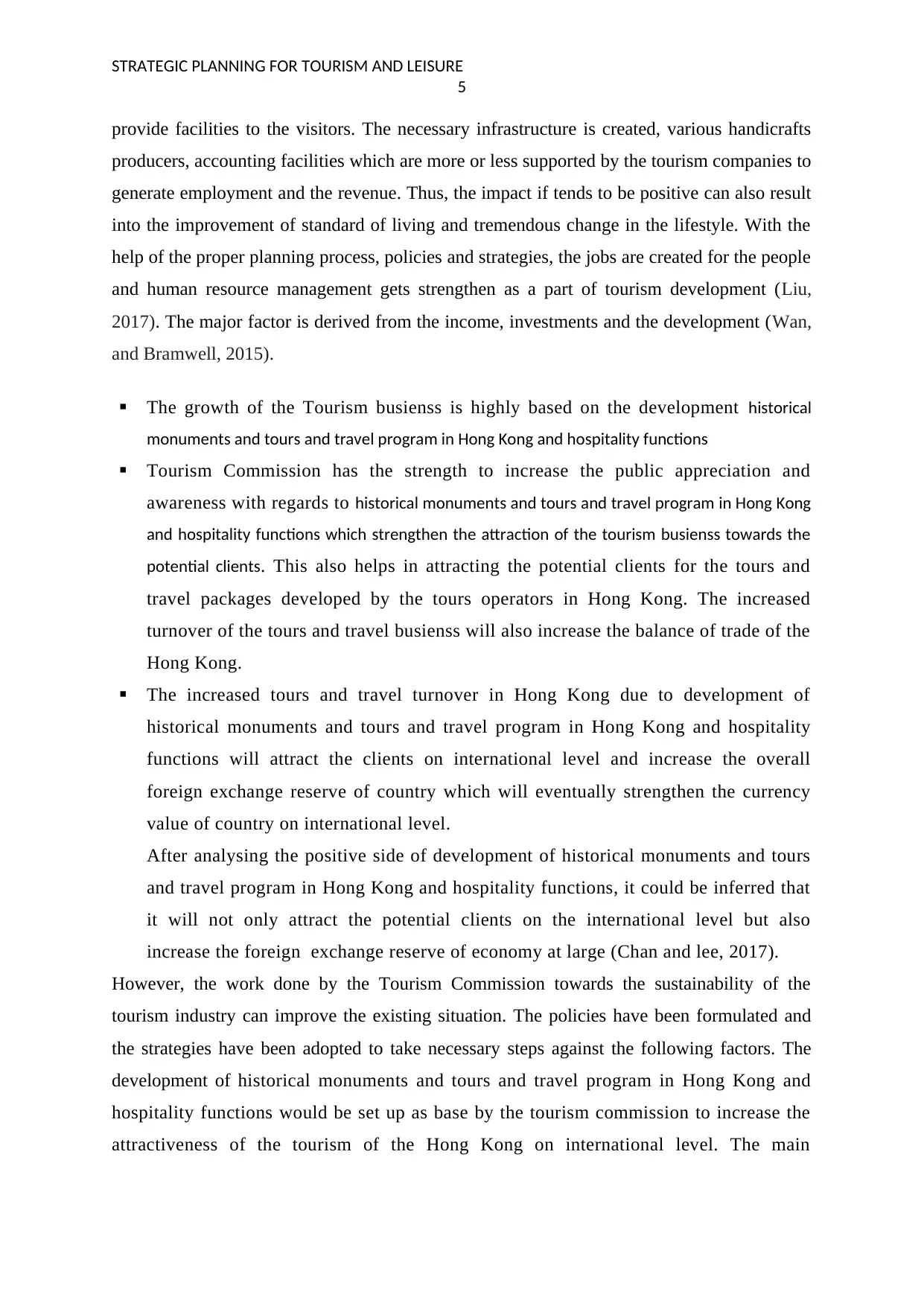
STRATEGIC PLANNING FOR TOURISM AND LEISURE
5
provide facilities to the visitors. The necessary infrastructure is created, various handicrafts
producers, accounting facilities which are more or less supported by the tourism companies to
generate employment and the revenue. Thus, the impact if tends to be positive can also result
into the improvement of standard of living and tremendous change in the lifestyle. With the
help of the proper planning process, policies and strategies, the jobs are created for the people
and human resource management gets strengthen as a part of tourism development (Liu,
2017). The major factor is derived from the income, investments and the development (Wan,
and Bramwell, 2015).
The growth of the Tourism busienss is highly based on the development historical
monuments and tours and travel program in Hong Kong and hospitality functions
Tourism Commission has the strength to increase the public appreciation and
awareness with regards to historical monuments and tours and travel program in Hong Kong
and hospitality functions which strengthen the attraction of the tourism busienss towards the
potential clients. This also helps in attracting the potential clients for the tours and
travel packages developed by the tours operators in Hong Kong. The increased
turnover of the tours and travel busienss will also increase the balance of trade of the
Hong Kong.
The increased tours and travel turnover in Hong Kong due to development of
historical monuments and tours and travel program in Hong Kong and hospitality
functions will attract the clients on international level and increase the overall
foreign exchange reserve of country which will eventually strengthen the currency
value of country on international level.
After analysing the positive side of development of historical monuments and tours
and travel program in Hong Kong and hospitality functions, it could be inferred that
it will not only attract the potential clients on the international level but also
increase the foreign exchange reserve of economy at large (Chan and lee, 2017).
However, the work done by the Tourism Commission towards the sustainability of the
tourism industry can improve the existing situation. The policies have been formulated and
the strategies have been adopted to take necessary steps against the following factors. The
development of historical monuments and tours and travel program in Hong Kong and
hospitality functions would be set up as base by the tourism commission to increase the
attractiveness of the tourism of the Hong Kong on international level. The main
5
provide facilities to the visitors. The necessary infrastructure is created, various handicrafts
producers, accounting facilities which are more or less supported by the tourism companies to
generate employment and the revenue. Thus, the impact if tends to be positive can also result
into the improvement of standard of living and tremendous change in the lifestyle. With the
help of the proper planning process, policies and strategies, the jobs are created for the people
and human resource management gets strengthen as a part of tourism development (Liu,
2017). The major factor is derived from the income, investments and the development (Wan,
and Bramwell, 2015).
The growth of the Tourism busienss is highly based on the development historical
monuments and tours and travel program in Hong Kong and hospitality functions
Tourism Commission has the strength to increase the public appreciation and
awareness with regards to historical monuments and tours and travel program in Hong Kong
and hospitality functions which strengthen the attraction of the tourism busienss towards the
potential clients. This also helps in attracting the potential clients for the tours and
travel packages developed by the tours operators in Hong Kong. The increased
turnover of the tours and travel busienss will also increase the balance of trade of the
Hong Kong.
The increased tours and travel turnover in Hong Kong due to development of
historical monuments and tours and travel program in Hong Kong and hospitality
functions will attract the clients on international level and increase the overall
foreign exchange reserve of country which will eventually strengthen the currency
value of country on international level.
After analysing the positive side of development of historical monuments and tours
and travel program in Hong Kong and hospitality functions, it could be inferred that
it will not only attract the potential clients on the international level but also
increase the foreign exchange reserve of economy at large (Chan and lee, 2017).
However, the work done by the Tourism Commission towards the sustainability of the
tourism industry can improve the existing situation. The policies have been formulated and
the strategies have been adopted to take necessary steps against the following factors. The
development of historical monuments and tours and travel program in Hong Kong and
hospitality functions would be set up as base by the tourism commission to increase the
attractiveness of the tourism of the Hong Kong on international level. The main
⊘ This is a preview!⊘
Do you want full access?
Subscribe today to unlock all pages.

Trusted by 1+ million students worldwide
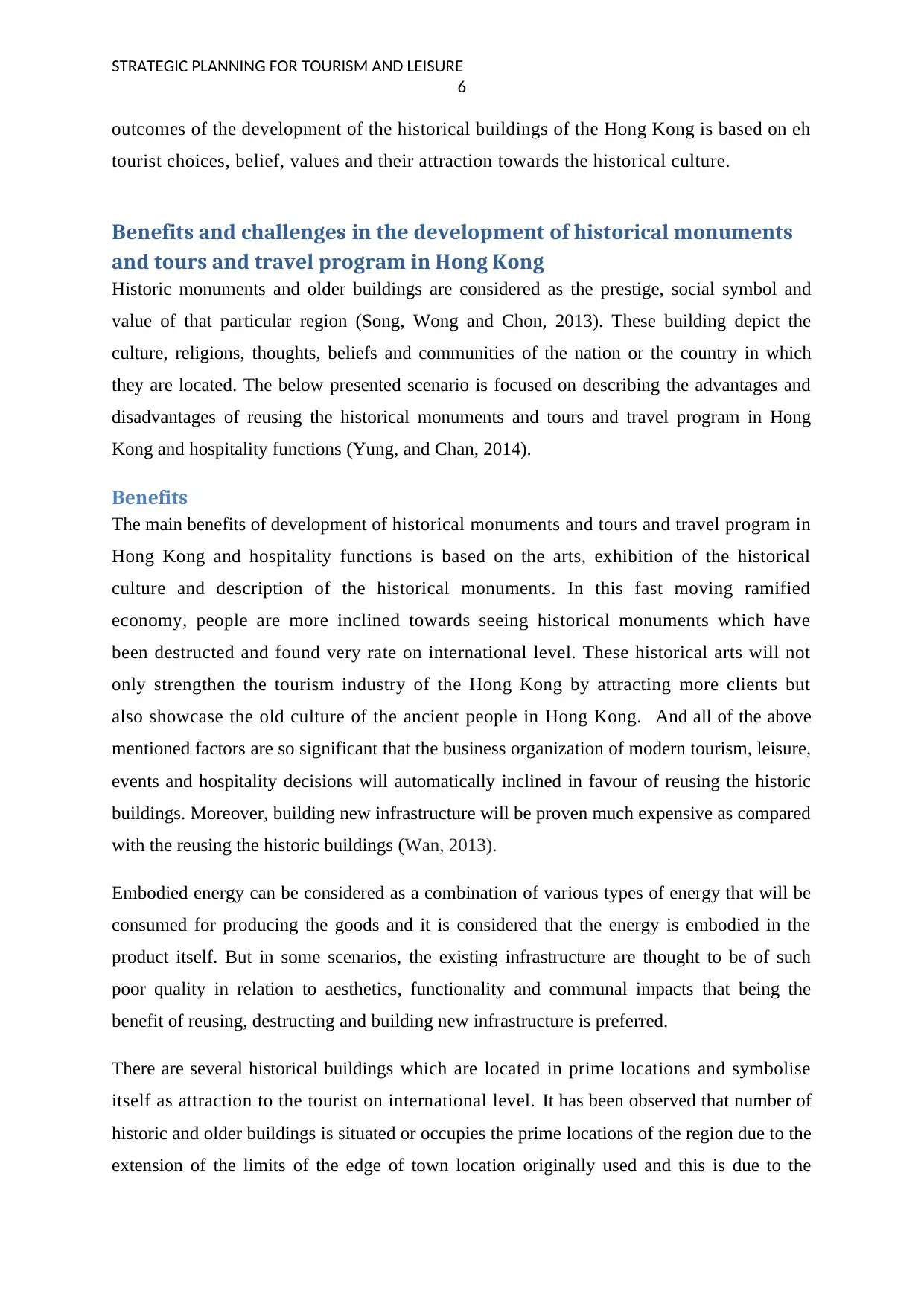
STRATEGIC PLANNING FOR TOURISM AND LEISURE
6
outcomes of the development of the historical buildings of the Hong Kong is based on eh
tourist choices, belief, values and their attraction towards the historical culture.
Benefits and challenges in the development of historical monuments
and tours and travel program in Hong Kong
Historic monuments and older buildings are considered as the prestige, social symbol and
value of that particular region (Song, Wong and Chon, 2013). These building depict the
culture, religions, thoughts, beliefs and communities of the nation or the country in which
they are located. The below presented scenario is focused on describing the advantages and
disadvantages of reusing the historical monuments and tours and travel program in Hong
Kong and hospitality functions (Yung, and Chan, 2014).
Benefits
The main benefits of development of historical monuments and tours and travel program in
Hong Kong and hospitality functions is based on the arts, exhibition of the historical
culture and description of the historical monuments. In this fast moving ramified
economy, people are more inclined towards seeing historical monuments which have
been destructed and found very rate on international level. These historical arts will not
only strengthen the tourism industry of the Hong Kong by attracting more clients but
also showcase the old culture of the ancient people in Hong Kong. And all of the above
mentioned factors are so significant that the business organization of modern tourism, leisure,
events and hospitality decisions will automatically inclined in favour of reusing the historic
buildings. Moreover, building new infrastructure will be proven much expensive as compared
with the reusing the historic buildings (Wan, 2013).
Embodied energy can be considered as a combination of various types of energy that will be
consumed for producing the goods and it is considered that the energy is embodied in the
product itself. But in some scenarios, the existing infrastructure are thought to be of such
poor quality in relation to aesthetics, functionality and communal impacts that being the
benefit of reusing, destructing and building new infrastructure is preferred.
There are several historical buildings which are located in prime locations and symbolise
itself as attraction to the tourist on international level. It has been observed that number of
historic and older buildings is situated or occupies the prime locations of the region due to the
extension of the limits of the edge of town location originally used and this is due to the
6
outcomes of the development of the historical buildings of the Hong Kong is based on eh
tourist choices, belief, values and their attraction towards the historical culture.
Benefits and challenges in the development of historical monuments
and tours and travel program in Hong Kong
Historic monuments and older buildings are considered as the prestige, social symbol and
value of that particular region (Song, Wong and Chon, 2013). These building depict the
culture, religions, thoughts, beliefs and communities of the nation or the country in which
they are located. The below presented scenario is focused on describing the advantages and
disadvantages of reusing the historical monuments and tours and travel program in Hong
Kong and hospitality functions (Yung, and Chan, 2014).
Benefits
The main benefits of development of historical monuments and tours and travel program in
Hong Kong and hospitality functions is based on the arts, exhibition of the historical
culture and description of the historical monuments. In this fast moving ramified
economy, people are more inclined towards seeing historical monuments which have
been destructed and found very rate on international level. These historical arts will not
only strengthen the tourism industry of the Hong Kong by attracting more clients but
also showcase the old culture of the ancient people in Hong Kong. And all of the above
mentioned factors are so significant that the business organization of modern tourism, leisure,
events and hospitality decisions will automatically inclined in favour of reusing the historic
buildings. Moreover, building new infrastructure will be proven much expensive as compared
with the reusing the historic buildings (Wan, 2013).
Embodied energy can be considered as a combination of various types of energy that will be
consumed for producing the goods and it is considered that the energy is embodied in the
product itself. But in some scenarios, the existing infrastructure are thought to be of such
poor quality in relation to aesthetics, functionality and communal impacts that being the
benefit of reusing, destructing and building new infrastructure is preferred.
There are several historical buildings which are located in prime locations and symbolise
itself as attraction to the tourist on international level. It has been observed that number of
historic and older buildings is situated or occupies the prime locations of the region due to the
extension of the limits of the edge of town location originally used and this is due to the
Paraphrase This Document
Need a fresh take? Get an instant paraphrase of this document with our AI Paraphraser
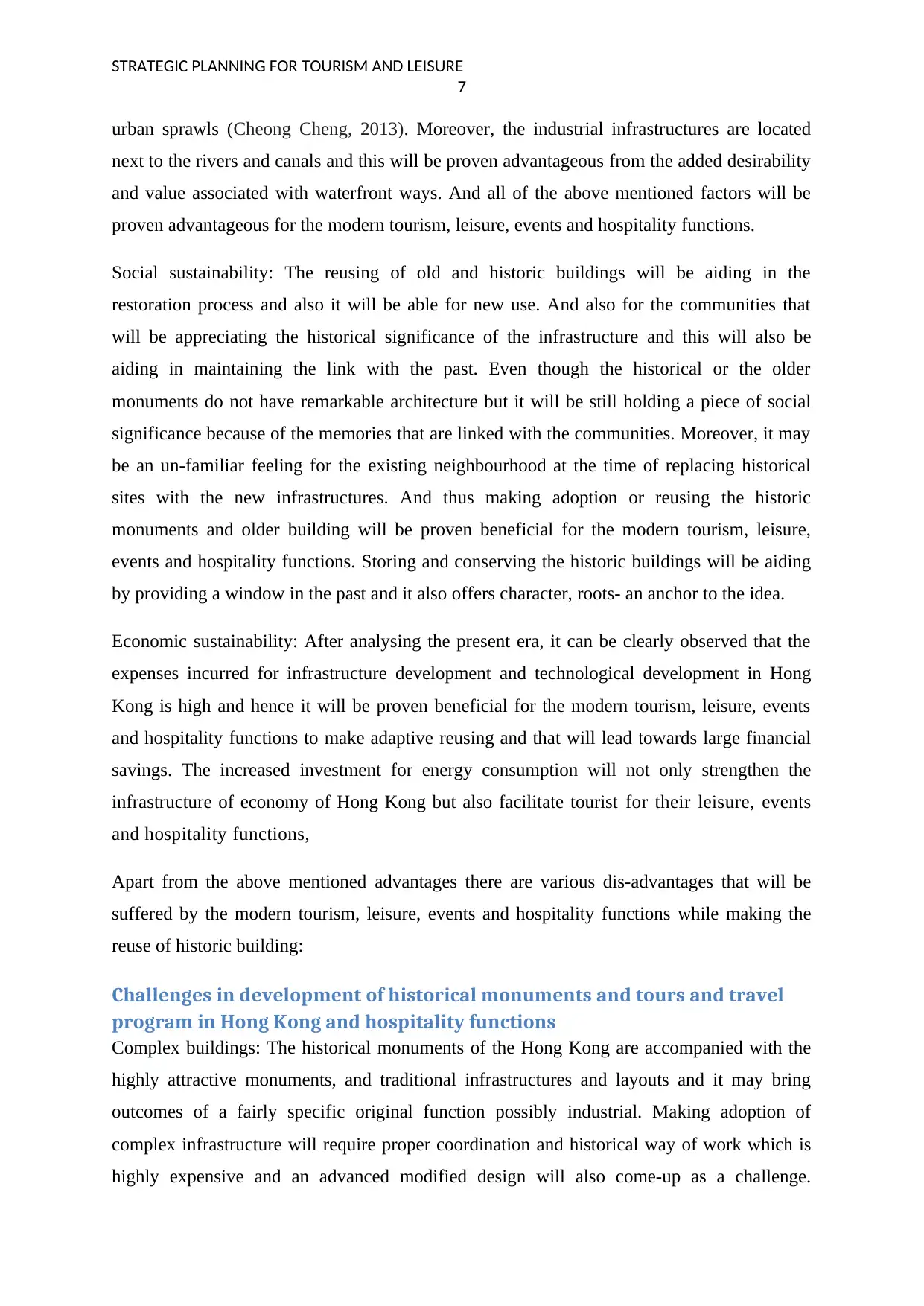
STRATEGIC PLANNING FOR TOURISM AND LEISURE
7
urban sprawls (Cheong Cheng, 2013). Moreover, the industrial infrastructures are located
next to the rivers and canals and this will be proven advantageous from the added desirability
and value associated with waterfront ways. And all of the above mentioned factors will be
proven advantageous for the modern tourism, leisure, events and hospitality functions.
Social sustainability: The reusing of old and historic buildings will be aiding in the
restoration process and also it will be able for new use. And also for the communities that
will be appreciating the historical significance of the infrastructure and this will also be
aiding in maintaining the link with the past. Even though the historical or the older
monuments do not have remarkable architecture but it will be still holding a piece of social
significance because of the memories that are linked with the communities. Moreover, it may
be an un-familiar feeling for the existing neighbourhood at the time of replacing historical
sites with the new infrastructures. And thus making adoption or reusing the historic
monuments and older building will be proven beneficial for the modern tourism, leisure,
events and hospitality functions. Storing and conserving the historic buildings will be aiding
by providing a window in the past and it also offers character, roots- an anchor to the idea.
Economic sustainability: After analysing the present era, it can be clearly observed that the
expenses incurred for infrastructure development and technological development in Hong
Kong is high and hence it will be proven beneficial for the modern tourism, leisure, events
and hospitality functions to make adaptive reusing and that will lead towards large financial
savings. The increased investment for energy consumption will not only strengthen the
infrastructure of economy of Hong Kong but also facilitate tourist for their leisure, events
and hospitality functions,
Apart from the above mentioned advantages there are various dis-advantages that will be
suffered by the modern tourism, leisure, events and hospitality functions while making the
reuse of historic building:
Challenges in development of historical monuments and tours and travel
program in Hong Kong and hospitality functions
Complex buildings: The historical monuments of the Hong Kong are accompanied with the
highly attractive monuments, and traditional infrastructures and layouts and it may bring
outcomes of a fairly specific original function possibly industrial. Making adoption of
complex infrastructure will require proper coordination and historical way of work which is
highly expensive and an advanced modified design will also come-up as a challenge.
7
urban sprawls (Cheong Cheng, 2013). Moreover, the industrial infrastructures are located
next to the rivers and canals and this will be proven advantageous from the added desirability
and value associated with waterfront ways. And all of the above mentioned factors will be
proven advantageous for the modern tourism, leisure, events and hospitality functions.
Social sustainability: The reusing of old and historic buildings will be aiding in the
restoration process and also it will be able for new use. And also for the communities that
will be appreciating the historical significance of the infrastructure and this will also be
aiding in maintaining the link with the past. Even though the historical or the older
monuments do not have remarkable architecture but it will be still holding a piece of social
significance because of the memories that are linked with the communities. Moreover, it may
be an un-familiar feeling for the existing neighbourhood at the time of replacing historical
sites with the new infrastructures. And thus making adoption or reusing the historic
monuments and older building will be proven beneficial for the modern tourism, leisure,
events and hospitality functions. Storing and conserving the historic buildings will be aiding
by providing a window in the past and it also offers character, roots- an anchor to the idea.
Economic sustainability: After analysing the present era, it can be clearly observed that the
expenses incurred for infrastructure development and technological development in Hong
Kong is high and hence it will be proven beneficial for the modern tourism, leisure, events
and hospitality functions to make adaptive reusing and that will lead towards large financial
savings. The increased investment for energy consumption will not only strengthen the
infrastructure of economy of Hong Kong but also facilitate tourist for their leisure, events
and hospitality functions,
Apart from the above mentioned advantages there are various dis-advantages that will be
suffered by the modern tourism, leisure, events and hospitality functions while making the
reuse of historic building:
Challenges in development of historical monuments and tours and travel
program in Hong Kong and hospitality functions
Complex buildings: The historical monuments of the Hong Kong are accompanied with the
highly attractive monuments, and traditional infrastructures and layouts and it may bring
outcomes of a fairly specific original function possibly industrial. Making adoption of
complex infrastructure will require proper coordination and historical way of work which is
highly expensive and an advanced modified design will also come-up as a challenge.
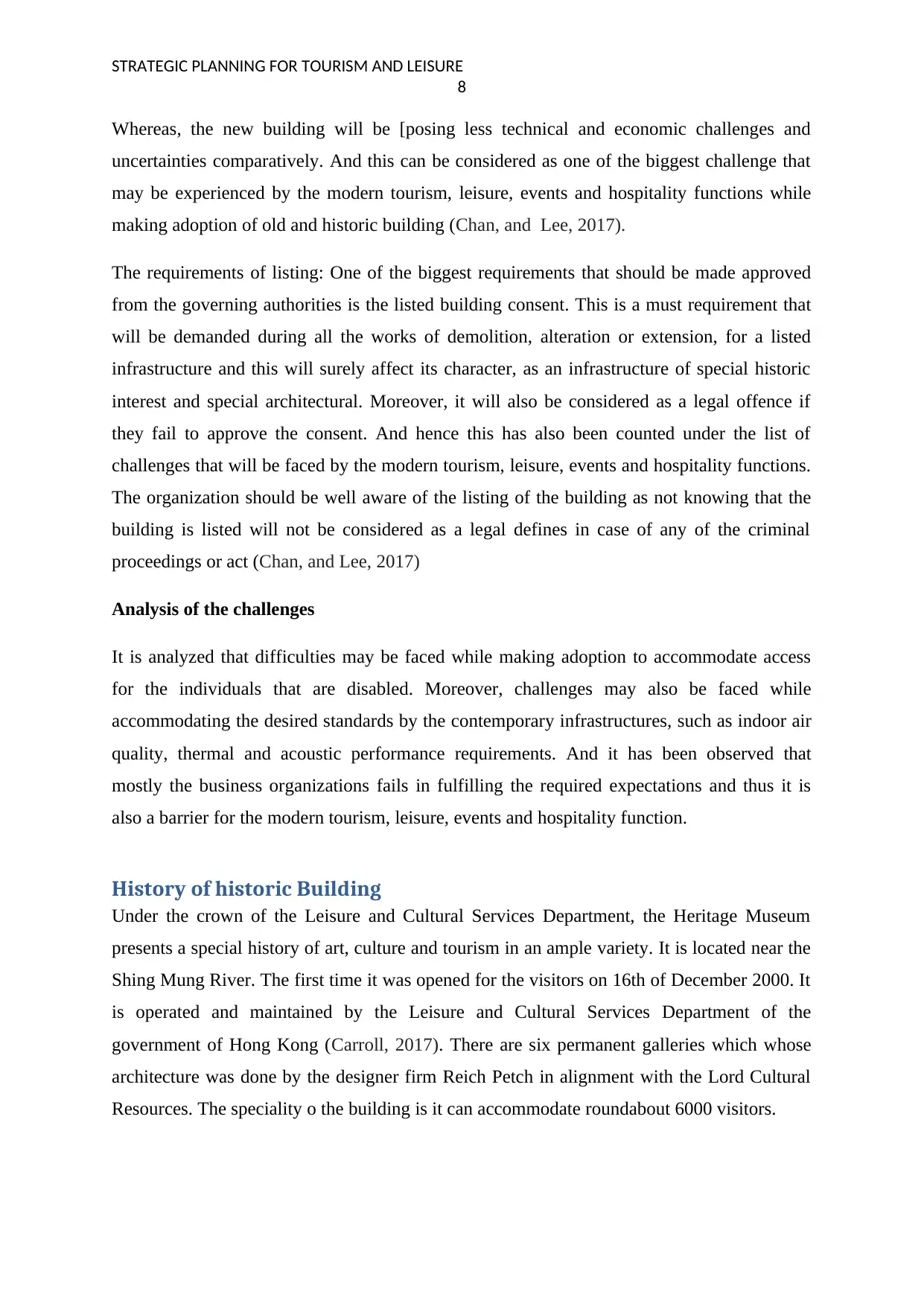
STRATEGIC PLANNING FOR TOURISM AND LEISURE
8
Whereas, the new building will be [posing less technical and economic challenges and
uncertainties comparatively. And this can be considered as one of the biggest challenge that
may be experienced by the modern tourism, leisure, events and hospitality functions while
making adoption of old and historic building (Chan, and Lee, 2017).
The requirements of listing: One of the biggest requirements that should be made approved
from the governing authorities is the listed building consent. This is a must requirement that
will be demanded during all the works of demolition, alteration or extension, for a listed
infrastructure and this will surely affect its character, as an infrastructure of special historic
interest and special architectural. Moreover, it will also be considered as a legal offence if
they fail to approve the consent. And hence this has also been counted under the list of
challenges that will be faced by the modern tourism, leisure, events and hospitality functions.
The organization should be well aware of the listing of the building as not knowing that the
building is listed will not be considered as a legal defines in case of any of the criminal
proceedings or act (Chan, and Lee, 2017)
Analysis of the challenges
It is analyzed that difficulties may be faced while making adoption to accommodate access
for the individuals that are disabled. Moreover, challenges may also be faced while
accommodating the desired standards by the contemporary infrastructures, such as indoor air
quality, thermal and acoustic performance requirements. And it has been observed that
mostly the business organizations fails in fulfilling the required expectations and thus it is
also a barrier for the modern tourism, leisure, events and hospitality function.
History of historic Building
Under the crown of the Leisure and Cultural Services Department, the Heritage Museum
presents a special history of art, culture and tourism in an ample variety. It is located near the
Shing Mung River. The first time it was opened for the visitors on 16th of December 2000. It
is operated and maintained by the Leisure and Cultural Services Department of the
government of Hong Kong (Carroll, 2017). There are six permanent galleries which whose
architecture was done by the designer firm Reich Petch in alignment with the Lord Cultural
Resources. The speciality o the building is it can accommodate roundabout 6000 visitors.
8
Whereas, the new building will be [posing less technical and economic challenges and
uncertainties comparatively. And this can be considered as one of the biggest challenge that
may be experienced by the modern tourism, leisure, events and hospitality functions while
making adoption of old and historic building (Chan, and Lee, 2017).
The requirements of listing: One of the biggest requirements that should be made approved
from the governing authorities is the listed building consent. This is a must requirement that
will be demanded during all the works of demolition, alteration or extension, for a listed
infrastructure and this will surely affect its character, as an infrastructure of special historic
interest and special architectural. Moreover, it will also be considered as a legal offence if
they fail to approve the consent. And hence this has also been counted under the list of
challenges that will be faced by the modern tourism, leisure, events and hospitality functions.
The organization should be well aware of the listing of the building as not knowing that the
building is listed will not be considered as a legal defines in case of any of the criminal
proceedings or act (Chan, and Lee, 2017)
Analysis of the challenges
It is analyzed that difficulties may be faced while making adoption to accommodate access
for the individuals that are disabled. Moreover, challenges may also be faced while
accommodating the desired standards by the contemporary infrastructures, such as indoor air
quality, thermal and acoustic performance requirements. And it has been observed that
mostly the business organizations fails in fulfilling the required expectations and thus it is
also a barrier for the modern tourism, leisure, events and hospitality function.
History of historic Building
Under the crown of the Leisure and Cultural Services Department, the Heritage Museum
presents a special history of art, culture and tourism in an ample variety. It is located near the
Shing Mung River. The first time it was opened for the visitors on 16th of December 2000. It
is operated and maintained by the Leisure and Cultural Services Department of the
government of Hong Kong (Carroll, 2017). There are six permanent galleries which whose
architecture was done by the designer firm Reich Petch in alignment with the Lord Cultural
Resources. The speciality o the building is it can accommodate roundabout 6000 visitors.
⊘ This is a preview!⊘
Do you want full access?
Subscribe today to unlock all pages.

Trusted by 1+ million students worldwide
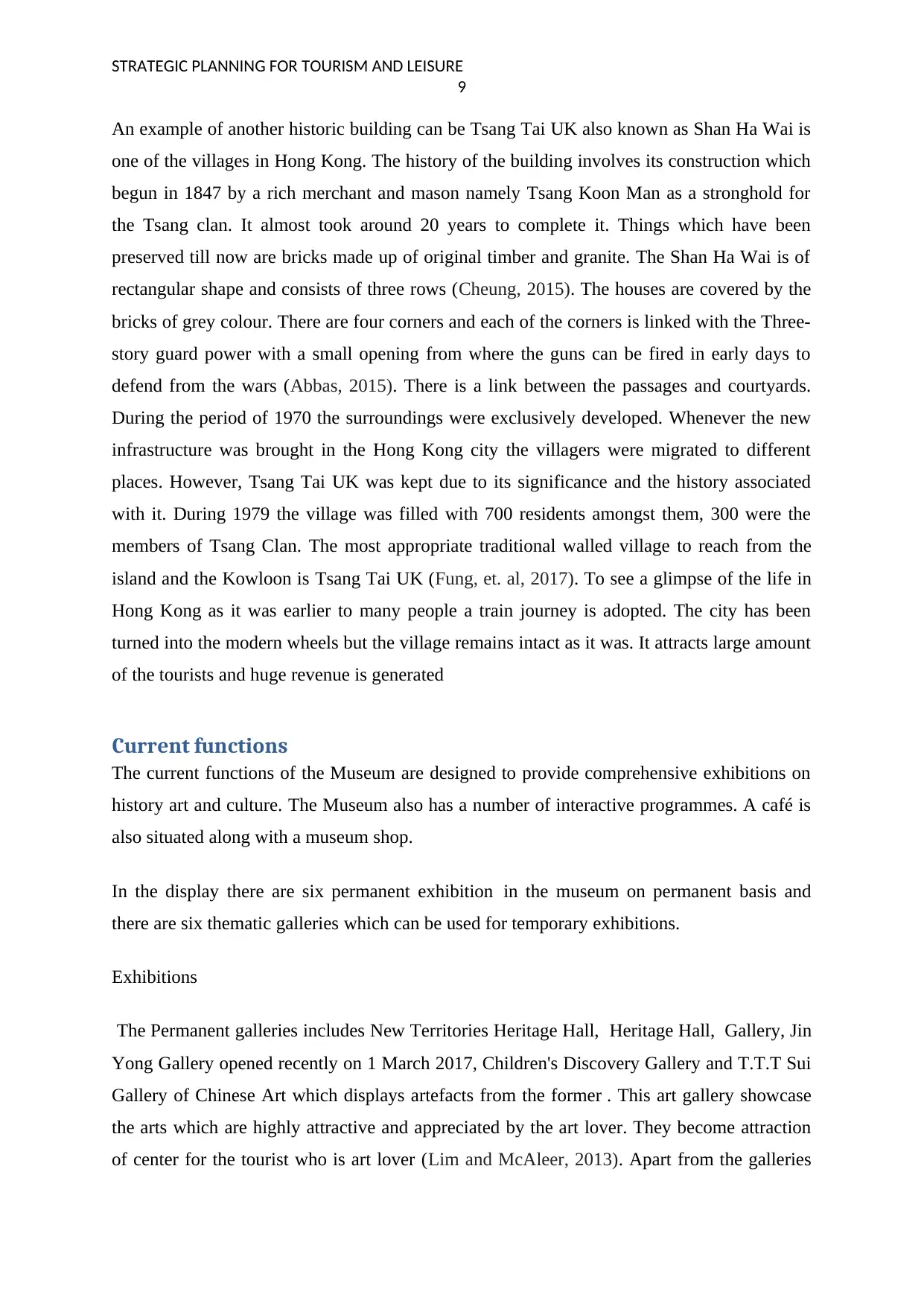
STRATEGIC PLANNING FOR TOURISM AND LEISURE
9
An example of another historic building can be Tsang Tai UK also known as Shan Ha Wai is
one of the villages in Hong Kong. The history of the building involves its construction which
begun in 1847 by a rich merchant and mason namely Tsang Koon Man as a stronghold for
the Tsang clan. It almost took around 20 years to complete it. Things which have been
preserved till now are bricks made up of original timber and granite. The Shan Ha Wai is of
rectangular shape and consists of three rows (Cheung, 2015). The houses are covered by the
bricks of grey colour. There are four corners and each of the corners is linked with the Three-
story guard power with a small opening from where the guns can be fired in early days to
defend from the wars (Abbas, 2015). There is a link between the passages and courtyards.
During the period of 1970 the surroundings were exclusively developed. Whenever the new
infrastructure was brought in the Hong Kong city the villagers were migrated to different
places. However, Tsang Tai UK was kept due to its significance and the history associated
with it. During 1979 the village was filled with 700 residents amongst them, 300 were the
members of Tsang Clan. The most appropriate traditional walled village to reach from the
island and the Kowloon is Tsang Tai UK (Fung, et. al, 2017). To see a glimpse of the life in
Hong Kong as it was earlier to many people a train journey is adopted. The city has been
turned into the modern wheels but the village remains intact as it was. It attracts large amount
of the tourists and huge revenue is generated
Current functions
The current functions of the Museum are designed to provide comprehensive exhibitions on
history art and culture. The Museum also has a number of interactive programmes. A café is
also situated along with a museum shop.
In the display there are six permanent exhibition in the museum on permanent basis and
there are six thematic galleries which can be used for temporary exhibitions.
Exhibitions
The Permanent galleries includes New Territories Heritage Hall, Heritage Hall, Gallery, Jin
Yong Gallery opened recently on 1 March 2017, Children's Discovery Gallery and T.T.T Sui
Gallery of Chinese Art which displays artefacts from the former . This art gallery showcase
the arts which are highly attractive and appreciated by the art lover. They become attraction
of center for the tourist who is art lover (Lim and McAleer, 2013). Apart from the galleries
9
An example of another historic building can be Tsang Tai UK also known as Shan Ha Wai is
one of the villages in Hong Kong. The history of the building involves its construction which
begun in 1847 by a rich merchant and mason namely Tsang Koon Man as a stronghold for
the Tsang clan. It almost took around 20 years to complete it. Things which have been
preserved till now are bricks made up of original timber and granite. The Shan Ha Wai is of
rectangular shape and consists of three rows (Cheung, 2015). The houses are covered by the
bricks of grey colour. There are four corners and each of the corners is linked with the Three-
story guard power with a small opening from where the guns can be fired in early days to
defend from the wars (Abbas, 2015). There is a link between the passages and courtyards.
During the period of 1970 the surroundings were exclusively developed. Whenever the new
infrastructure was brought in the Hong Kong city the villagers were migrated to different
places. However, Tsang Tai UK was kept due to its significance and the history associated
with it. During 1979 the village was filled with 700 residents amongst them, 300 were the
members of Tsang Clan. The most appropriate traditional walled village to reach from the
island and the Kowloon is Tsang Tai UK (Fung, et. al, 2017). To see a glimpse of the life in
Hong Kong as it was earlier to many people a train journey is adopted. The city has been
turned into the modern wheels but the village remains intact as it was. It attracts large amount
of the tourists and huge revenue is generated
Current functions
The current functions of the Museum are designed to provide comprehensive exhibitions on
history art and culture. The Museum also has a number of interactive programmes. A café is
also situated along with a museum shop.
In the display there are six permanent exhibition in the museum on permanent basis and
there are six thematic galleries which can be used for temporary exhibitions.
Exhibitions
The Permanent galleries includes New Territories Heritage Hall, Heritage Hall, Gallery, Jin
Yong Gallery opened recently on 1 March 2017, Children's Discovery Gallery and T.T.T Sui
Gallery of Chinese Art which displays artefacts from the former . This art gallery showcase
the arts which are highly attractive and appreciated by the art lover. They become attraction
of center for the tourist who is art lover (Lim and McAleer, 2013). Apart from the galleries
Paraphrase This Document
Need a fresh take? Get an instant paraphrase of this document with our AI Paraphraser
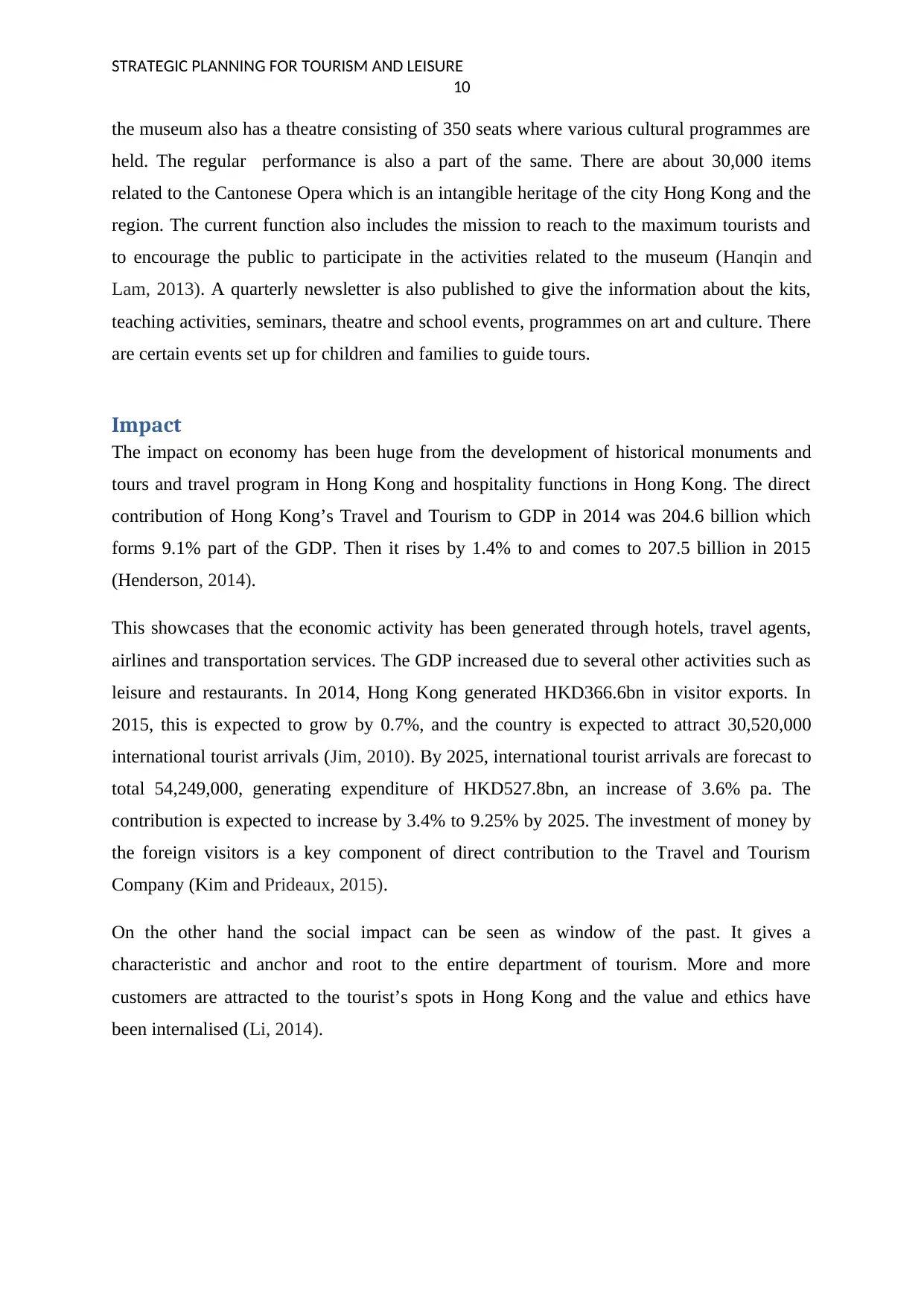
STRATEGIC PLANNING FOR TOURISM AND LEISURE
10
the museum also has a theatre consisting of 350 seats where various cultural programmes are
held. The regular performance is also a part of the same. There are about 30,000 items
related to the Cantonese Opera which is an intangible heritage of the city Hong Kong and the
region. The current function also includes the mission to reach to the maximum tourists and
to encourage the public to participate in the activities related to the museum (Hanqin and
Lam, 2013). A quarterly newsletter is also published to give the information about the kits,
teaching activities, seminars, theatre and school events, programmes on art and culture. There
are certain events set up for children and families to guide tours.
Impact
The impact on economy has been huge from the development of historical monuments and
tours and travel program in Hong Kong and hospitality functions in Hong Kong. The direct
contribution of Hong Kong’s Travel and Tourism to GDP in 2014 was 204.6 billion which
forms 9.1% part of the GDP. Then it rises by 1.4% to and comes to 207.5 billion in 2015
(Henderson, 2014).
This showcases that the economic activity has been generated through hotels, travel agents,
airlines and transportation services. The GDP increased due to several other activities such as
leisure and restaurants. In 2014, Hong Kong generated HKD366.6bn in visitor exports. In
2015, this is expected to grow by 0.7%, and the country is expected to attract 30,520,000
international tourist arrivals (Jim, 2010). By 2025, international tourist arrivals are forecast to
total 54,249,000, generating expenditure of HKD527.8bn, an increase of 3.6% pa. The
contribution is expected to increase by 3.4% to 9.25% by 2025. The investment of money by
the foreign visitors is a key component of direct contribution to the Travel and Tourism
Company (Kim and Prideaux, 2015).
On the other hand the social impact can be seen as window of the past. It gives a
characteristic and anchor and root to the entire department of tourism. More and more
customers are attracted to the tourist’s spots in Hong Kong and the value and ethics have
been internalised (Li, 2014).
10
the museum also has a theatre consisting of 350 seats where various cultural programmes are
held. The regular performance is also a part of the same. There are about 30,000 items
related to the Cantonese Opera which is an intangible heritage of the city Hong Kong and the
region. The current function also includes the mission to reach to the maximum tourists and
to encourage the public to participate in the activities related to the museum (Hanqin and
Lam, 2013). A quarterly newsletter is also published to give the information about the kits,
teaching activities, seminars, theatre and school events, programmes on art and culture. There
are certain events set up for children and families to guide tours.
Impact
The impact on economy has been huge from the development of historical monuments and
tours and travel program in Hong Kong and hospitality functions in Hong Kong. The direct
contribution of Hong Kong’s Travel and Tourism to GDP in 2014 was 204.6 billion which
forms 9.1% part of the GDP. Then it rises by 1.4% to and comes to 207.5 billion in 2015
(Henderson, 2014).
This showcases that the economic activity has been generated through hotels, travel agents,
airlines and transportation services. The GDP increased due to several other activities such as
leisure and restaurants. In 2014, Hong Kong generated HKD366.6bn in visitor exports. In
2015, this is expected to grow by 0.7%, and the country is expected to attract 30,520,000
international tourist arrivals (Jim, 2010). By 2025, international tourist arrivals are forecast to
total 54,249,000, generating expenditure of HKD527.8bn, an increase of 3.6% pa. The
contribution is expected to increase by 3.4% to 9.25% by 2025. The investment of money by
the foreign visitors is a key component of direct contribution to the Travel and Tourism
Company (Kim and Prideaux, 2015).
On the other hand the social impact can be seen as window of the past. It gives a
characteristic and anchor and root to the entire department of tourism. More and more
customers are attracted to the tourist’s spots in Hong Kong and the value and ethics have
been internalised (Li, 2014).
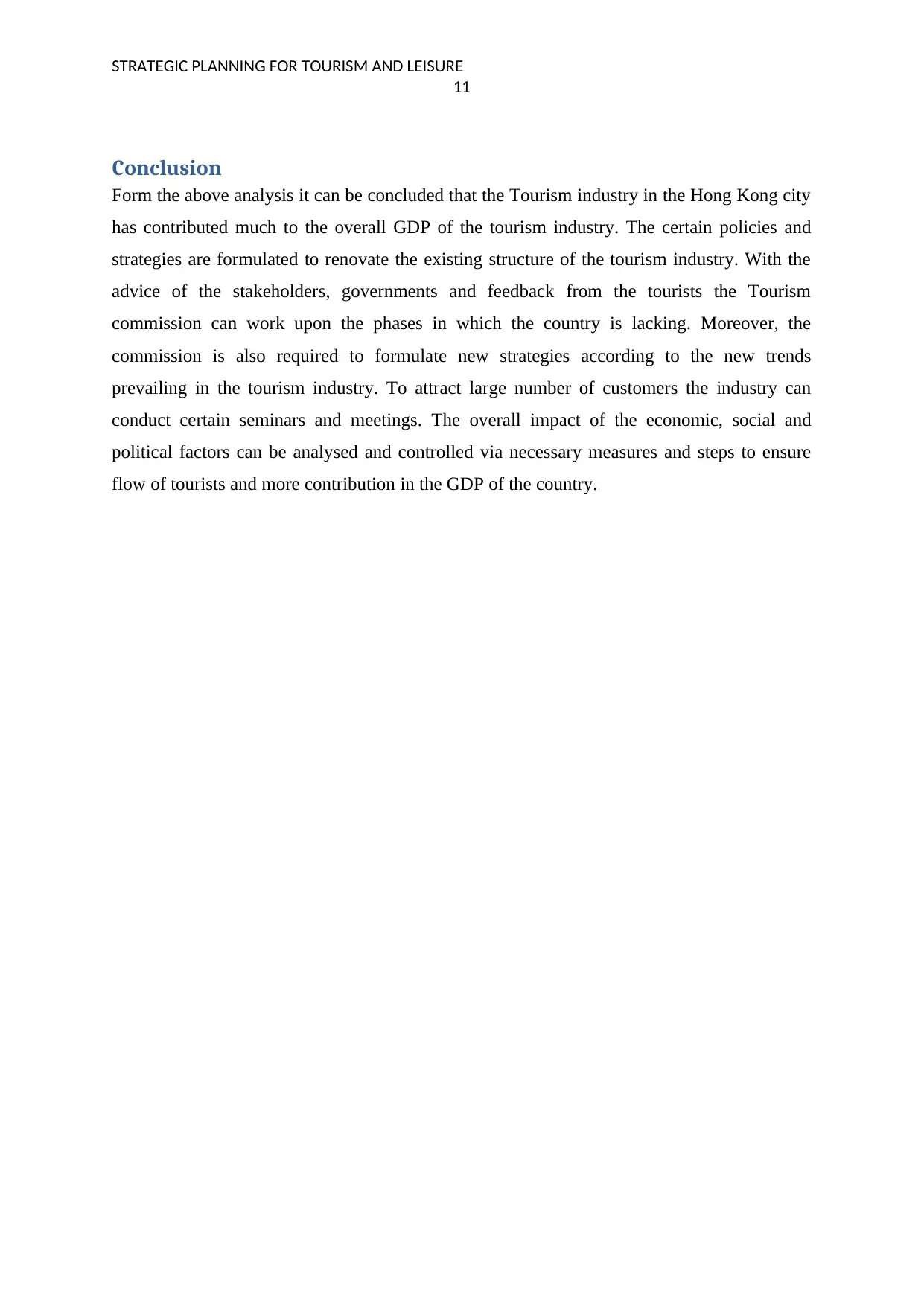
STRATEGIC PLANNING FOR TOURISM AND LEISURE
11
Conclusion
Form the above analysis it can be concluded that the Tourism industry in the Hong Kong city
has contributed much to the overall GDP of the tourism industry. The certain policies and
strategies are formulated to renovate the existing structure of the tourism industry. With the
advice of the stakeholders, governments and feedback from the tourists the Tourism
commission can work upon the phases in which the country is lacking. Moreover, the
commission is also required to formulate new strategies according to the new trends
prevailing in the tourism industry. To attract large number of customers the industry can
conduct certain seminars and meetings. The overall impact of the economic, social and
political factors can be analysed and controlled via necessary measures and steps to ensure
flow of tourists and more contribution in the GDP of the country.
11
Conclusion
Form the above analysis it can be concluded that the Tourism industry in the Hong Kong city
has contributed much to the overall GDP of the tourism industry. The certain policies and
strategies are formulated to renovate the existing structure of the tourism industry. With the
advice of the stakeholders, governments and feedback from the tourists the Tourism
commission can work upon the phases in which the country is lacking. Moreover, the
commission is also required to formulate new strategies according to the new trends
prevailing in the tourism industry. To attract large number of customers the industry can
conduct certain seminars and meetings. The overall impact of the economic, social and
political factors can be analysed and controlled via necessary measures and steps to ensure
flow of tourists and more contribution in the GDP of the country.
⊘ This is a preview!⊘
Do you want full access?
Subscribe today to unlock all pages.

Trusted by 1+ million students worldwide
1 out of 15
Related Documents
Your All-in-One AI-Powered Toolkit for Academic Success.
+13062052269
info@desklib.com
Available 24*7 on WhatsApp / Email
![[object Object]](/_next/static/media/star-bottom.7253800d.svg)
Unlock your academic potential
Copyright © 2020–2025 A2Z Services. All Rights Reserved. Developed and managed by ZUCOL.





